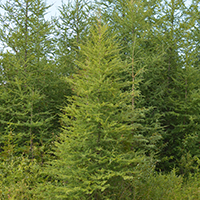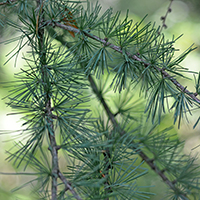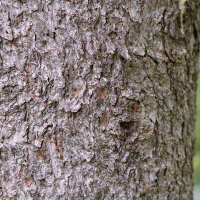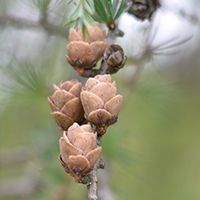What tamarack looks like
Size and shape
- Medium tree that reaches 20 metres tall.
- Stem can be up to 60 centimetres in diameter.
Needles
- Grow in tufts of 10 to 20 (sometimes many more).
- 2 to 3 centimetres long.
- Soft, flexible and bluish green.
- Turn yellow in fall before dropping.
Bark
- Smooth and gray when the tree is young.
- Turns reddish brown and scaly as the tree grows.
Cones
- Seeds grow inside light brown cones (1 to 2 centimetres long).
- Trees don't produce seeds until they are 10 years old.
Where tamarack is found
Tamarack is found across Ontario but is most common in the north.
What you need to know to grow tamarack
- Moisture: tolerates varied moisture levels but is often found on wet sites.
- Shade: intolerant of shade — needs full sun.
- Soil: grows in a variety of soils.
Benefits and uses of tamarack
Wildlife benefits
Tamarack is not a major food source for wildlife but provides habitat and shade.
Commercial uses
The wood from tamarack is used for:
- posts, poles, and railway ties
- pulp
- wooden ships
Tannins can be extracted from tamarack bark and used for tanning leather.
Fun facts about tamarack
- It is found in every province and territory in Canada.
- Most conifer trees keep their needles year-round, but tamaracks are deciduous conifers — their needles fall off in autumn and new ones grow in spring.
- Tamarack is great for landscaping because of its nice shape and brilliant yellow needles in fall.
Updated: January 23, 2024
Published: July 18, 2014



